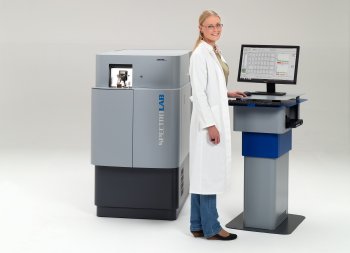SPECTRO Analytical Instruments unveiled the updated version of its SPECTROLAB metal analyzer at the GIFA foundry trade show (Dusseldorf, Germany, June 28-July 2, 2011). The latest version of the versatile metal analyzer incorporates a number of improvements, and, in several instances, achieves better detection limits than its predecessor version, e.g. trace analysis of pure copper and aluminum.
"Since our introduction of the first SPECTROLAB equipped with a hybrid optic in 2007, we've seen enormous interest in this technology everywhere," comments Kay Toedter, Product Manager for Stationary Metal Analyzers for SPECTRO. "For many users, the combination of the two detector technologies opens new possibilities for improvements in laboratory analytical performance."

"This latest SPECTROLAB offers the advantages of photomultiplier detectors relative to single spark evaluation and time-resolved spectroscopy along with the flexible line selection and ability to combine analytical and reference lines from charge-coupled device detectors. By combining all of these advantages, the SPECTROLAB analyzer delivers the lowest detection limits with a previously unattainable stability and repeatability of measurement results," he adds.
Optimized excitation parameters and an innovative readout system enable permanent enhancements for lead analysis with a focus on battery technology or in the analysis of precious metals, for example. Even during automotive and aerospace materials testing, the new SPECTROLAB analyzer displays its unique strengths, notes Mr. Toedter.
"The new SPECTROLAB analyzer is able to analyze aluminum, magnesium and titanium alloys with a single hardware configuration. With the complexity of spectra, this was long considered impossible, because the number and selection of lines was limited by the positioning of the PMT detectors. With the new SPECTROLAB analyzer, the entire spectrum from 120 nm to 780nm now is available to users," explains Mr. Toedter.
"The new instrument offers unique flexibility that provides completely new options for incoming and outgoing controls or the analysis of unknown metallic materials. In addition, with its optimized optical resolution and a focal width of 750 nm in both optical segments, the new SPECTROLAB achieves outstanding analytical results for trace analysis of pure metals and the examination of all conceivable material combinations and alloys," he concludes.
Low Maintenance and Operating Costs
In re-designing the SPECTROLAB stationary metal analyzer, SPECTRO placed special emphasis on ease of operation and reduced operating costs. With those considerations in mind, SPECTRO placed components that could require maintenance in easily accessible locations. An extended diagnosis and log file system also assist users in monitoring the instrument's status and in performing accurate trouble shooting, helping to lengthen maintenance intervals and shorten repair times.
As a high-end optical emission spectrometer, the SPECTROLAB analyzer addresses needs of metal producers and processing companies as well as those of the automotive and aviation industries. The versatile instrument is especially well suited for use in quality management applications and for material analysis for incoming and outgoing controls.
SPECTROLAB also is an attractive and cost-effective solution for businesses that work with many different metals, and have had, until now, to maintain multiple analyzers. Because the SPECTROLAB can be configured to analyze all ten common base materials, the instrument covers all daily instrument requirements, making a second instrument superfluous.